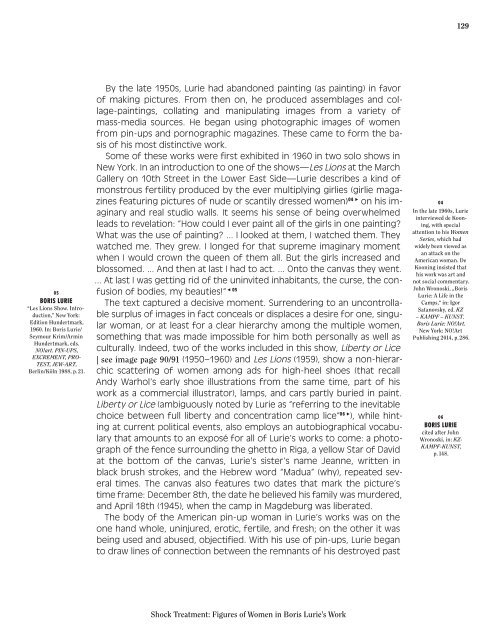The Art of
Katalog_Boris-Lurie_English
Katalog_Boris-Lurie_English
Create successful ePaper yourself
Turn your PDF publications into a flip-book with our unique Google optimized e-Paper software.
129<br />
05<br />
BORIS LURIE<br />
“Les Lions Show. Introduction,”<br />
New York:<br />
Edition Hundertmark,<br />
1960. In: Boris Lurie/<br />
Seymour Krim/Armin<br />
Hundertmark, eds.<br />
NO!art. PIN-UPS,<br />
EXCREMENT, PRO-<br />
TEST, JEW-ART,<br />
Berlin/Köln 1988, p. 21.<br />
By the late 1950s, Lurie had abandoned painting (as painting) in favor<br />
<strong>of</strong> making pictures. From then on, he produced assemblages and collage-paintings,<br />
collating and manipulating images from a variety <strong>of</strong><br />
mass-media sources. He began using photographic images <strong>of</strong> women<br />
from pin-ups and pornographic magazines. <strong>The</strong>se came to form the basis<br />
<strong>of</strong> his most distinctive work.<br />
Some <strong>of</strong> these works were first exhibited in 1960 in two solo shows in<br />
New York. In an introduction to one <strong>of</strong> the shows—Les Lions at the March<br />
Gallery on 10th Street in the Lower East Side—Lurie describes a kind <strong>of</strong><br />
monstrous fertility produced by the ever multiplying girlies (girlie magazines<br />
featuring pictures <strong>of</strong> nude or scantily dressed women) 04 on his imaginary<br />
and real studio walls. It seems his sense <strong>of</strong> being overwhelmed<br />
leads to revelation: “How could I ever paint all <strong>of</strong> the girls in one painting?<br />
What was the use <strong>of</strong> painting? ... I looked at them, I watched them. <strong>The</strong>y<br />
watched me. <strong>The</strong>y grew. I longed for that supreme imaginary moment<br />
when I would crown the queen <strong>of</strong> them all. But the girls increased and<br />
blossomed. ... And then at last I had to act. ... Onto the canvas they went.<br />
... At last I was getting rid <strong>of</strong> the uninvited inhabitants, the curse, the confusion<br />
<strong>of</strong> bodies, my beauties!” 05<br />
<strong>The</strong> text captured a decisive moment. Surrendering to an uncontrollable<br />
surplus <strong>of</strong> images in fact conceals or displaces a desire for one, singular<br />
woman, or at least for a clear hierarchy among the multiple women,<br />
something that was made impossible for him both personally as well as<br />
culturally. Indeed, two <strong>of</strong> the works included in this show, Liberty or Lice<br />
| see image page 90/91 (1950–1960) and Les Lions (1959), show a non-hierarchic<br />
scattering <strong>of</strong> women among ads for high-heel shoes (that recall<br />
Andy Warhol’s early shoe illustrations from the same time, part <strong>of</strong> his<br />
work as a commercial illustrator), lamps, and cars partly buried in paint.<br />
Liberty or Lice (ambiguously noted by Lurie as “referring to the inevitable<br />
choice between full liberty and concentration camp lice” 06 ), while hinting<br />
at current political events, also employs an autobiographical vocabulary<br />
that amounts to an exposé for all <strong>of</strong> Lurie’s works to come: a photograph<br />
<strong>of</strong> the fence surrounding the ghetto in Riga, a yellow Star <strong>of</strong> David<br />
at the bottom <strong>of</strong> the canvas, Lurie’s sister’s name Jeanne, written in<br />
black brush strokes, and the Hebrew word “Madua” (why), repeated several<br />
times. <strong>The</strong> canvas also features two dates that mark the picture’s<br />
time frame: December 8th, the date he believed his family was murdered,<br />
and April 18th (1945), when the camp in Magdeburg was liberated.<br />
<strong>The</strong> body <strong>of</strong> the American pin-up woman in Lurie’s works was on the<br />
one hand whole, uninjured, erotic, fertile, and fresh; on the other it was<br />
being used and abused, objectified. With his use <strong>of</strong> pin-ups, Lurie began<br />
to draw lines <strong>of</strong> connection between the remnants <strong>of</strong> his destroyed past<br />
04<br />
In the late 1960s, Lurie<br />
interviewed de Kooning,<br />
with special<br />
attention to his Women<br />
Series, which had<br />
widely been viewed as<br />
an attack on the<br />
American woman. De<br />
Kooning insisted that<br />
his work was art and<br />
not social commentary.<br />
John Wronoski, „Boris<br />
Lurie: A Life in the<br />
Camps,“ in: Igor<br />
Satanovsky, ed. KZ<br />
– KAMPF – KUNST.<br />
Boris Lurie: NO!<strong>Art</strong>.<br />
New York: NO!<strong>Art</strong><br />
Publishing 2014, p. 286.<br />
06<br />
BORIS LURIE<br />
cited after John<br />
Wronoski, in: KZ-<br />
KAMPF-KUNST,<br />
p. 148.<br />
Shock Treatment: Figures <strong>of</strong> Women in Boris Lurie’s Work



